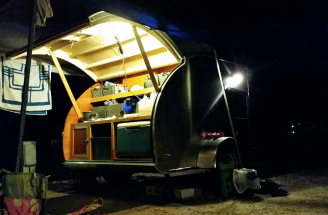I think we have the design narrowed down to a 5x10, bow front (i.e. camp-inn raindrop inspired). Just working on the trailer type/source for the most part right now. Would like to buy used, but most of the used in this area are over priced, unless they are junk. I want too start out on the right foot, and having a crappy trailer isn't the way to do it.
Question is this when looking for trailers, since that seems like the obvious starting point.
Can we use a 5x8 northern tool trailer since they are easier to come by than a 5x10? I want to try and fit the front box on, AND have room for a propane cylinder.
My thought is to buy the 5x8 northern tool and then get 2ft more welded on the back (seem's pretty simple, and cheap), then slide the axle/springs rearward to the 35/40% distance from the rear. This will leave the stock distance from frame to tongue on the front, enough for box and propane.
Also how are the stock hubs, we want to have 14 or 15" wheels on it? Can the stock wheels be easiliy changed out to 14 or 15" rims?
5x10 Bowfront, Raindrop on 5x8 frame?? or 5x10
11 posts
• Page 1 of 1
5x10 Bowfront, Raindrop on 5x8 frame?? or 5x10
Brian
Checkout my buildThe Regal Eagle Bow front for 4

Also my teardrop updates from blog on Dad Rambles
Checkout my buildThe Regal Eagle Bow front for 4
Also my teardrop updates from blog on Dad Rambles
-

Gunguy05 - The 300 Club
- Posts: 385
- Images: 6
- Joined: Mon Dec 02, 2013 4:45 pm
- Location: South GA
Re: 5x10 Bowfront, Raindrop on 5x8 frame?? or 5x10
No need to add to the frame I have a two 5 x 10 trailers on 8 foot frames. Just let the walls and floor cantilever out over the frame.
If you are getting the single tongue trailer you will want to reinforce the tongue My barn is built on a very similar namco 5x8 cargo trailer and the thing had been overloaded and bent the second crossmember down where the tongue ends.
If you are getting the single tongue trailer you will want to reinforce the tongue My barn is built on a very similar namco 5x8 cargo trailer and the thing had been overloaded and bent the second crossmember down where the tongue ends.
Growing older but not up !
-

bobhenry - Ten Grand Club

- Posts: 10368
- Images: 2623
- Joined: Fri Feb 09, 2007 7:49 am
- Location: INDIANA, LINDEN
